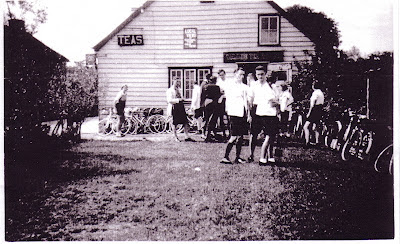Welcome to this month’s round-up of local
history and heritage in and around Blackmore, Essex.
Essex
Society for Archaeology and History
One of the County’s oldest societies turns
160 this year. Founded in 1852 in
Colchester the Essex Archaeological Society, as it was originally known
continues to this day arranging excursions / visits for its members and
producing annually its Transactions, titled ‘Essex Archaeology and
History’. In April 2012 the 1st
volume of the Fourth Series was published (cover illustrated). Articles of very local interest include
‘Roman Billericay: excavations by the Billericay Archaeological and Historical
Society, 1970-1977’ (by M Medlycot et al) and ‘Revd. John Howard Marsden: rector
of Great Oakley and first Disney professor of archaeology at Cambridge
University’ (by Michael Leach) – the Disney referred to here was John Disney of
The Hyde, Ingatestone, during the mid-nineteenth century. To buy a copy of the 384 page publication, go
to http://www.blackmorehistory.co.uk/esah.html
.
For information about the Society itself
and membership – we are always looking for new members – go to the website: http://www.essex.ac.uk/history/esah/
The Essex Society for Archaeology and
History has a number of surplus books for sale, which are not required for
accession to the Society’s Library hosted at Essex University or are duplicates
of items already held. As a member I am
hosting on this sister website a book sale on http://www.blackmorehistory.co.uk/esah.html.
Why am I a member? As an amateur enthusiast it is good to meet
like-minded people who are professional or keen historians, archaeologists,
researchers etc. I have found membership
very interesting indeed. The Society’s
objectives are:
-
To
promote and encourage the study of the archaeology and history of the historic
county of Essex.
-
In
furtherance of the above, to publish the results of such studies in its journal
and to disseminate information on matters relating to archaeology and history
in Essex through appropriate media.
-
To
organise conferences, lectures and visits for the benefit of members of the
Society and interested members of the public; to educate the wider community in
the archaeological heritage of Essex; to co-operate with other bodies on
matters of common interest and concern
-
To
provide library facilities for Society members and approved members of the
public.
Blackmore
Village Website
Blackmore Village Website (BVW) has had a
major revamp and re-launch under a new author – under a new domain name. The site (http://www.blackmorevillage.com/p/home.html
) went live on 28 August. At the core is
a copy of the old website but with a blog attached and a promise of Facebook
and twitter links. Of interest to local
historians is the ‘History page’ (http://www.blackmorevillage.com/p/history.html
) which make reference to the sister website to this blog, Blackmore Area Local
History (http://www.blackmorehistory.co.uk/
), referring to it as “an absolute must”.
Deal
Tree Medical Centre
The former Doddinghurst Surgery closed its
doors on 17 August, moving across the road that weekend to newly built premises
at Deal Tree Corner on the Blackmore Road by Hook End. The building lies just within Doddinghurst
parish adjacent to the boundaries of Blackmore and Stondon Massey.
‘Demolished’
Victorian Letter Box
When I passed Ship Road in West
Hanningfield on 1 September 2012 I noticed a pile of bricks surrounded by red
and white tape. Clearly some mishap had
happened with the Victorian Letter Box. http://blackmorehistory.blogspot.co.uk/2008/12/west-hanningfield-victorian-post-box-3.html
Links
For an extensive list of links to other
sites go to: http://www.blackmorehistory.co.uk/externallinks.html




